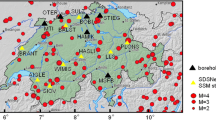Abstract
A single scattering model was used to analyse the temporary changes in the mean density of scattered waves in a discrete random medium. The model of the mean energy density, originally proposed bySato (1977) for spherical radiation and isotropic scattering, has been modified and applied to a medium in which the scatterers are confined to a specified volume. The time variation of the early part of the mean energy density function for the different source durations was investigated. The dominant effect on the theoretical mean energy density is caused by the specified volume containing scatterers. The duration of the source pulse influences the early part of the coda fort/t 0<1.2, wheret is the lapse time measured from the source origin time, andt 0is arrival time of the body wave.
The analysis of the coda signal of micro-events occurring immediately in front of the face enables us to estimate the size of the fracture zone induced by the stope. The model of the mean energy density of coda for a medium containing scatterers close to the seismic source was used to analyse a large number of events recorded close to an advancing mine face in a deep level gold mine in South Africa. The coda decay rate has two trends: the first, with a steep decay of coda, is produced by a larger deviation of rock parameters and/or larger size of the scatterers; the second trend, which decays more slowly, has the corresponding mean-free path ranging from 20 m to 200 m. The analysis indicates that the rock mass about 15–20 m from the stope contains a large proportion of fractured and blocked rock, which is the source of scattering. The scattering of theS-wave was much stronger and more stable, with the mean-free path varying from 11 m to 45 m. This is due to the shorter wavelength of theS wave in comparison with theP wave. The quality factor for theP coda wave varies from 30 to 100 in the fracture zone of stope and outside this zone it has a value of 300. The quality factor of theS wave varies from 20 to 78 in the equivalent volume. For rock surrounding the stope the ratioQ −1 sp /Q −1 ss varied from 0.31 to 0.69. This suggests that the radii of scatterers are smaller than 3.5 m.
Similar content being viewed by others
References
Aki, K. andChouet, B. (1975),Origin of coda wave. Wave source, attenuation and scattering effects, J. Geophys. Res.80, 3322–3342.
Brummer, R. K. (1984),The significance of the layered nature of the rock surrounding mining excavations from the point of view of numerical modelling. Unpublished Research Report, Chamber of Mines of South Africa Research Organisation.
Cichowicz, A. (1985),Analysis of accelerograms from Western Deep Levels microseismic network. Unpublished Research Report, Chamber of Mines of South Africa Research Organization.
Cichowicz, A., Green, R. W. E., andvan Zyl Brink, A. (1988),Coda polarization properties of high frequency microseismic events, Bull. Seism. Soc. Am.78, 1297–1318.
Frankel, A. andClayton, R. W. (1986),Finite difference simulations of seismic scattering: Implications for the propagation of short-period seismic waves in the crust and models of crustal heterogeneity, J. Geophys. Res.91, 6465–6489.
Gao, L. S., Lee, L. C., Biswars, N. N., andAki, K. (1983),Comparison of the effects between single and multiple scattering on coda waves for local earthquakes, Bull. Seism. Soc. Am.73, 377–389.
Gradshteyn, I. S. andRyzhik, I. J.,Table of Integrals, Series, and Products (Academic Press, 1980).
Jin, A. andAki, K. (1986),Temporal change in Coda Q before the Tangshan aarthquake of 1976 and the Haicheng earthquake of 1975, J. Geophys. Res.,91, 665–673.
Kanaswich, E. R. (1981),Time Sequence Analysis in Geophysics (The University of Alberta Press).
Sato, H. (1977),Energy propagation including scattering effects, single isotopic scattering approximation, J. Phys. Earth.25, 27–41.
Sato, H. (1978),Mean force path of S waves under the Kanto district of Japan, J. Phys. Earth26, 185–198.
Sato, H. (1982),Coda wave excitation due to nonisotropic scattering and nonspherical source radiation, J. Geophys. Res.87, 8665–8674.
Sato, H. (1984),Attenuation and envelope formation of three-component seismograms of small local earthquakes in randomly inhomogeneous lithosphere, J. Geophys. Res.89, 1221–1241.
Author information
Authors and Affiliations
Rights and permissions
About this article
Cite this article
Cichowicz, A., Green, R.W.E. Changes in the early part of the seismic coda due to localized scatterers: The estimation ofQ in a stope environment. PAGEOPH 129, 497–511 (1989). https://doi.org/10.1007/BF00874521
Received:
Revised:
Accepted:
Issue Date:
DOI: https://doi.org/10.1007/BF00874521




